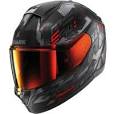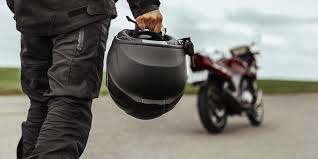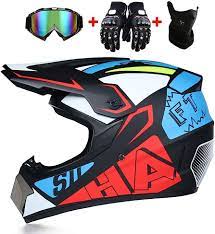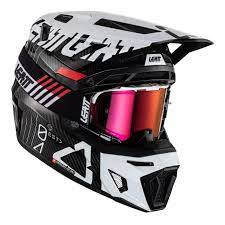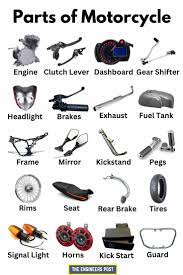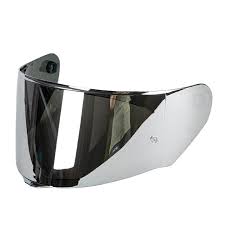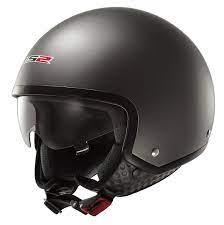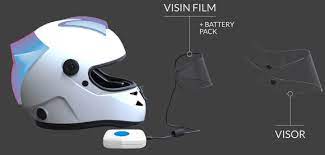
The motorcycle visor: A crucial element of rider safety and comfort
When it comes to riding a motorcycle, safety should always be a top priority. While helmets play a vital role in protecting the head, there is another essential component that often goes unnoticed but is equally important: the motorcycle visor.
The visor, located on the front of the helmet, serves multiple purposes that contribute to the overall safety and comfort of riders. Its primary function is to shield the eyes from various elements encountered on the road. Whether it’s dust, debris, insects, or even raindrops, a well-designed visor acts as a barrier between the rider’s eyes and potential hazards.
One of the key advantages of wearing a helmet with a visor is its ability to enhance visibility. A clear visor allows for an unobstructed view of the road ahead, ensuring riders can anticipate any obstacles or hazards in their path. Additionally, some visors are equipped with anti-fog coatings or ventilation systems that prevent fogging up during colder weather or humid conditions, further enhancing visibility and reducing distractions.
Furthermore, motorcycle visors also protect against harmful ultraviolet (UV) rays from the sun. Prolonged exposure to UV rays can lead to eye strain and even long-term damage such as cataracts. With a tinted or UV-protected visor, riders can enjoy clear vision while shielding their eyes from harmful sun rays.
Comfort is another crucial aspect that should not be overlooked when considering a motorcycle visor. Riding for extended periods can cause eye fatigue due to wind resistance and exposure to elements like dust or debris. A properly fitted visor helps reduce these discomforts by creating a barrier against wind and airborne particles. Some advanced models even feature adjustable vents that allow riders to regulate airflow for optimal comfort during different weather conditions.
It’s important to note that maintaining a clean and scratch-free motorcycle visor is essential for optimal performance. Regular cleaning with appropriate products and avoiding abrasive materials can help extend the lifespan of the visor, ensuring a clear and unobstructed view while riding.
In conclusion, the motorcycle visor is an often underestimated yet crucial component of rider safety and comfort. By providing protection against debris, enhancing visibility, shielding against harmful UV rays, and reducing wind resistance, a well-designed visor plays a significant role in creating a safe and enjoyable riding experience. So, whether you’re a seasoned rider or just starting out, make sure to invest in a high-quality helmet with a reliable visor to safeguard your eyes and enhance your overall riding experience. Stay safe on the road!
9 Advantages of Motorcycle Visors: Enhancing Safety, Improving Visibility, UV Protection, Reducing Eye Fatigue, Weather Adaptability, Comfortable Riding Experience, Shielding Against Insects, Scratch Resistance, and Customization Options
- Enhanced Safety
- Improved Visibility
- UV Protection
- Reduced Eye Fatigue
- Weather Adaptability
- Comfortable Riding Experience
- Shield Against Insects
- Scratch Resistance
- Customization Options
Challenges with Motorcycle Visors: Limited Peripheral Vision, Reduced Visibility in Low-Light Conditions, and Maintenance/Cleaning Requirements
- Limited peripheral vision
- Reduced visibility in low-light conditions
- Maintenance and cleaning requirements
Enhanced Safety
Enhanced Safety: Protecting Your Eyes with a Motorcycle Visor
When it comes to riding a motorcycle, safety should always be a top priority. One crucial element that contributes to rider safety is the motorcycle visor. This small but essential component provides an added layer of protection for the eyes, ensuring a clear vision and reducing the risk of potential hazards.
A motorcycle visor acts as a protective barrier between the rider’s eyes and various elements encountered on the road. Whether it’s dust, debris, insects, or raindrops, these hazards can pose significant risks to a rider’s vision and overall safety. However, with a well-designed visor in place, riders can confidently navigate through these challenges without compromising their sight.
Clear vision is paramount when riding a motorcycle. A visor helps maintain an unobstructed view of the road ahead, allowing riders to anticipate and react to any obstacles or dangers promptly. By shielding the eyes from flying debris or particles kicked up by other vehicles, the visor ensures that riders can focus on what matters most – safely navigating their way through traffic.
In addition to protecting against physical hazards, some motorcycle visors are equipped with anti-fog coatings or ventilation systems. These features prevent fogging up during colder weather or humid conditions where visibility can be significantly reduced. By keeping the visor clear and free from condensation, riders can ride comfortably and confidently without distractions.
Furthermore, wearing a helmet with a tinted or UV-protected visor offers protection against harmful ultraviolet (UV) rays from the sun. Prolonged exposure to UV rays can lead to eye strain and long-term damage such as cataracts. With a properly tinted or UV-protected visor, riders not only shield their eyes from harsh sunlight but also reduce glare for better visibility on bright sunny days.
In conclusion, enhanced safety is one of the key advantages of wearing a motorcycle visor. By providing a protective barrier against potential hazards, maintaining clear vision, and reducing the risk of eye injuries, the visor plays a vital role in ensuring the safety and well-being of riders. So, whether you’re embarking on a short commute or planning a long-distance ride, make sure to equip yourself with a reliable motorcycle visor to protect your eyes and enhance your overall riding experience. Stay safe and enjoy the open road!
Improved Visibility
Improved Visibility: A Clear Path to Safe Riding
When it comes to riding a motorcycle, having a clear view of the road ahead is absolutely crucial. That’s where the motorcycle visor comes into play, offering riders improved visibility and ensuring they can anticipate and react to any obstacles or hazards effectively.
A clear visor acts as a shield, keeping dust, debris, and insects at bay. By preventing these elements from obstructing the rider’s vision, it allows for an unobstructed view of the road. This unimpeded perspective is essential for spotting potential dangers in advance and reacting swiftly to them.
Imagine riding on a busy highway with wind gusts blowing dust and debris into your eyes. Without a quality visor, your vision would be compromised, making it challenging to navigate through traffic or react to sudden changes in road conditions. However, with a clear visor protecting your eyes, you have an advantage – a crystal-clear view of the road ahead.
Not only does the visor shield against external elements, but it also protects against glare from the sun. Riding during sunny days can often result in blinding sunlight that impairs visibility. A tinted or UV-protected visor reduces this glare significantly, allowing riders to maintain clear vision without squinting or straining their eyes.
Additionally, some advanced visors come equipped with anti-fog coatings or ventilation systems. These features address another common visibility issue faced by riders – fogging up due to temperature changes or humidity. By preventing fogging on the inside of the visor, these technologies ensure optimal visibility even in adverse weather conditions.
By providing an unobstructed view of the road ahead, motorcycle visors empower riders with increased awareness and better response capabilities. They allow for early detection of potential hazards such as potholes, debris on the road surface, or sudden vehicle movements that may require immediate action.
Remember, safety should always be a top priority when riding a motorcycle, and having a clear view of the road is an integral part of staying safe. So, invest in a high-quality helmet with a reliable visor that offers improved visibility. With an unobstructed view, you’ll be better equipped to navigate the roads confidently and enjoy your ride to the fullest.
UV Protection
UV Protection: Safeguarding Your Eyes on the Open Road
When it comes to motorcycle riding, protecting yourself from potential dangers is of utmost importance. While helmets are a standard safety measure, there’s one often overlooked feature that provides an additional layer of protection: the motorcycle visor.
One significant advantage of a motorcycle visor is its ability to shield your eyes from harmful ultraviolet (UV) rays emitted by the sun. Prolonged exposure to UV rays can lead to eye strain and even long-term damage such as cataracts. This is where the UV protection feature in many motorcycle visors comes into play.
Equipped with special UV coatings, these visors act as a barrier against the harmful effects of UV radiation. By wearing a helmet with a visor that offers UV protection, you can enjoy your ride while safeguarding your eyes from potential harm.
Not only does this protection reduce eye strain caused by bright sunlight, but it also minimizes the risk of long-term damage associated with prolonged exposure to UV rays. With a reliable UV-protected visor, you can ride with peace of mind knowing that your eyes are shielded from harmful radiation.
Whether you’re embarking on a sunny day trip or cruising through different weather conditions, having a motorcycle visor with UV protection is essential. It not only enhances your riding experience by reducing glare and improving visibility but also ensures the long-term health and well-being of your eyes.
Remember, just like any other safety gear, maintaining your motorcycle visor is crucial for optimal performance. Regular cleaning using appropriate products and avoiding abrasive materials will help preserve the clarity and effectiveness of the UV coating.
So, before you hit the road on your next adventure, make sure you have a helmet equipped with a high-quality visor offering reliable UV protection. Your eyes deserve nothing less than proper care and attention while enjoying the thrill of motorcycling. Stay safe and protected under the sun’s rays with a UV-protected visor.
Reduced Eye Fatigue
Reduced Eye Fatigue: Enhancing Comfort and Safety on Long Motorcycle Rides
Motorcycle enthusiasts know that long rides can be exhilarating, but they can also take a toll on the body, particularly the eyes. Wind resistance and exposure to elements like dust and debris can lead to eye fatigue, causing discomfort and potentially compromising safety. That’s where a well-fitted motorcycle visor comes into play.
One significant advantage of wearing a visor during extended rides is the reduction of eye fatigue. The visor acts as a protective barrier against wind, creating a smoother airflow around the rider’s face. This helps to minimize the strain caused by constant wind resistance, allowing riders to maintain focus and clarity throughout their journey.
Additionally, the visor shields the eyes from airborne particles such as dust or debris that can be encountered during rides. These particles not only cause irritation but can also obstruct vision, leading to further eye strain. With a reliable visor in place, riders can enjoy reduced exposure to these elements, resulting in less eye fatigue and increased comfort.
By reducing eye fatigue, a well-fitted motorcycle visor contributes to overall rider safety. Fatigue affects concentration levels and reaction times, both of which are crucial when navigating through traffic or encountering unexpected situations on the road. By alleviating eye strain and discomfort, riders are better equipped to stay alert and focused throughout their journey.
It is important for riders to choose a visor that fits properly and offers optimal protection against wind resistance and airborne particles. Regular maintenance is also key; keeping the visor clean and free from scratches ensures clear vision without any obstructions.
In conclusion, wearing a motorcycle visor not only protects against wind resistance and airborne particles but also significantly reduces eye fatigue during long rides. By providing a barrier against these elements, riders can enjoy increased comfort while maintaining focus and concentration on the road ahead. So gear up with a reliable visor before embarking on your next adventure, and experience the joy of riding without the strain on your eyes. Stay safe and enjoy the journey!
Weather Adaptability
Weather Adaptability: Enhancing Safety on the Road with Motorcycle Visor Features
When it comes to riding a motorcycle, weather conditions can greatly impact the overall experience and safety of the rider. One crucial advantage of motorcycle visors is their ability to adapt to different weather conditions, ensuring clear visibility and enhancing safety on the road.
Some motorcycle visors are equipped with anti-fog coatings or ventilation systems that effectively prevent fogging up during colder weather or humid conditions. This feature is a game-changer for riders, as fogged-up visors can severely impair visibility, making it difficult to navigate the road ahead.
During colder weather, when temperature differences between the inside and outside of the helmet occur, condensation can build up on the visor surface. However, with an anti-fog coating applied to the visor, riders can enjoy clear vision regardless of temperature changes. This prevents distractions and allows them to focus on their surroundings without compromising safety.
In humid conditions or during intense physical exertion while riding, such as in traffic or during off-road adventures, perspiration can accumulate inside the helmet. Without proper ventilation, this moisture can lead to fogging on the visor. However, certain motorcycle visors are designed with ventilation systems that allow for adequate airflow within the helmet. These strategically placed vents help dissipate heat and moisture, preventing fogging and ensuring clear visibility even in challenging weather conditions.
The weather adaptability feature of motorcycle visors not only enhances safety but also contributes to rider comfort. Clear visibility is essential for making split-second decisions on the road and anticipating potential hazards. With an anti-fog coating or effective ventilation system in place, riders can ride confidently knowing that their vision will remain unobstructed regardless of external factors.
It is important to note that regular maintenance and care are necessary to ensure optimal performance of these features. Cleaning your visor regularly using appropriate products will help maintain its anti-fog properties and prevent any buildup that could hinder visibility.
In conclusion, the weather adaptability feature of motorcycle visors plays a significant role in enhancing safety on the road. Whether it’s preventing fogging during colder weather or managing humidity during intense rides, these features ensure clear visibility in various weather conditions. By investing in a helmet with a visor equipped with anti-fog coatings or ventilation systems, riders can ride with confidence, knowing that their vision will remain unobstructed and their safety is prioritized.
Comfortable Riding Experience
Comfortable Riding Experience: Minimizing Discomfort with a Motorcycle Visor
When it comes to riding a motorcycle, comfort plays a significant role in ensuring an enjoyable experience on the road. While many factors contribute to rider comfort, one pro of the motorcycle visor stands out: it reduces wind resistance and minimizes discomfort caused by strong winds hitting directly on the eyes.
Strong winds can be a common occurrence while riding, especially at higher speeds or in open areas. Without a visor, riders may experience discomfort as the wind forcefully hits their face and eyes. This can lead to eye strain, watering eyes, and even difficulty maintaining focus on the road ahead.
However, with a properly fitted visor, riders can significantly reduce these discomforts. The visor acts as a shield against the wind, redirecting its force away from the eyes. By doing so, it creates a more aerodynamic profile for the rider’s face, reducing wind resistance and minimizing the direct impact of strong winds.
The result? A more comfortable riding experience. Riders can enjoy smoother airflow around their face and eyes, reducing eye strain and fatigue caused by battling against gusty winds. This allows for better concentration on the road ahead and enhances overall enjoyment during long rides or challenging weather conditions.
It’s important to note that choosing a well-fitted visor is crucial for optimal comfort. A visor that fits too loosely may not provide adequate protection against wind resistance, while one that is too tight could cause discomfort or pressure points on the face. Ensuring proper fitment through adjustment mechanisms or selecting helmets with customizable visors is essential.
In conclusion, one undeniable pro of wearing a motorcycle visor is its ability to enhance rider comfort by reducing wind resistance and minimizing discomfort caused by strong winds hitting directly on the eyes. By acting as a shield against gusty winds, a properly fitted visor creates a more aerodynamic profile for riders’ faces, allowing for a more enjoyable and comfortable riding experience. So, whether you’re cruising on the open road or facing challenging weather conditions, a reliable visor can make all the difference in ensuring your comfort and enjoyment while riding. Stay safe and comfortable on your motorcycle adventures!
Shield Against Insects
Shield Against Insects: The Unsung Hero of the Motorcycle Visor
When riding a motorcycle, there’s nothing quite like the feeling of freedom and exhilaration as you navigate the open road. However, one aspect that can quickly turn that joy into discomfort is encountering insects flying at high speeds. That’s where the motorcycle visor becomes an unsung hero.
Riding without a visor leaves your face vulnerable to these airborne creatures. Insects hitting your face directly can be not only distracting but also potentially dangerous, especially if they hit your eyes. The last thing any rider wants is to have their vision impaired by a sudden insect encounter.
This is where the motorcycle visor steps in as a protective shield against these pesky insects while ensuring clear vision. It acts as a barrier between your eyes and these flying critters, preventing them from making direct contact with your face.
The visor’s design takes into consideration the need for both protection and visibility. It allows you to maintain a clear line of sight while minimizing distractions caused by insects buzzing around. With a well-fitted visor, you can ride confidently, knowing that you are shielded from potential insect encounters.
Not only does the visor protect against insects, but it also adds an extra layer of comfort to your ride. Riding with bugs hitting your face can be quite unpleasant and may even cause irritation or allergic reactions for some individuals. By wearing a helmet with a visor, you can enjoy your ride without worrying about these unwanted guests spoiling the experience.
It’s important to keep in mind that maintaining a clean and scratch-free visor is crucial for optimal performance against insects. Regular cleaning and proper care will ensure that your visor remains transparent and effective in protecting against those pesky bugs.
So, whether you’re cruising through countryside roads or zipping through urban streets, don’t underestimate the value of a motorcycle visor in shielding against insects. It offers both protection and clear vision, allowing you to focus on the ride without any unwanted distractions. Stay safe, keep those insects at bay, and enjoy the freedom of the open road!
Scratch Resistance
Scratch Resistance: Enhancing Clarity and Longevity of Motorcycle Visors
When it comes to motorcycle visors, one important aspect that often gets overlooked is their scratch resistance. High-quality motorcycle visors are specifically designed with scratch-resistant materials, offering a multitude of benefits that contribute to both clarity and longevity.
During regular use, motorcycle visors are exposed to various elements such as dust, debris, insects, and even occasional accidental brushes against surfaces. These encounters can leave behind minor scratches on the visor’s surface, potentially impairing the rider’s vision. However, with a scratch-resistant visor, riders can enjoy peace of mind knowing that their visibility remains uncompromised.
The scratch-resistant properties of these visors help maintain clarity over time by minimizing the impact of minor abrasions. Even after repeated cleaning routines or accidental contact with rough surfaces, a high-quality scratch-resistant visor will retain its transparency and provide an unobstructed view of the road ahead.
Moreover, this feature significantly extends the lifespan of the motorcycle visor. By reducing the occurrence of scratches and maintaining its pristine condition for longer periods, riders can save money in the long run by avoiding frequent replacements or repairs.
It’s worth noting that proper care and maintenance play a crucial role in preserving the scratch resistance of a motorcycle visor. Using recommended cleaning products and avoiding abrasive materials when wiping or drying the visor ensures its longevity and effectiveness.
In conclusion, investing in a motorcycle visor with scratch-resistant properties is a wise choice for riders seeking enhanced clarity and durability. By minimizing the impact of minor abrasions caused by regular use or cleaning routines, these high-quality visors ensure optimal visibility throughout their lifespan. So whether you’re embarking on an adventurous ride or simply commuting through city streets, choose a scratch-resistant motorcycle visor to experience uninterrupted clarity and peace of mind on every journey.
Customization Options
Customization Options: Enhancing Style and Safety with Motorcycle Visor Tints
When it comes to personalizing your motorcycle gear, the motorcycle visor offers a fantastic opportunity for customization. With a wide range of tint options available, riders can choose the level of sun protection and visibility that best suits their preferences. This not only adds a personal touch to the riding experience but also ensures optimal eye safety.
Motorcycle visors come in various tints, ranging from clear to dark smoke or mirrored finishes. Clear visors provide excellent visibility in all lighting conditions, making them ideal for night rides or low-light situations. On the other hand, tinted visors offer additional sun protection during bright daylight hours by reducing glare and filtering out harmful UV rays.
The ability to customize your visor tint allows you to adapt to different weather conditions and riding environments. For example, if you frequently ride in sunny areas or during summer months, opting for a darker tint can significantly reduce eye strain caused by intense sunlight. It also enhances visibility by minimizing glare from reflective surfaces such as water or shiny objects on the road.
Moreover, the option to choose a specific tint adds a touch of style and individuality to your riding gear. Whether you prefer a sleek mirrored finish or a subtle smoke tint, customizing your visor allows you to express your personality while keeping safety at the forefront.
It’s important to note that different countries and regions may have specific regulations regarding visor tints for legal road use. Always ensure that your chosen tint complies with local laws and regulations before hitting the road.
In conclusion, motorcycle visors offer an exciting array of customization options through various tints. This allows riders to select their preferred level of sun protection and visibility while adding a personal touch to their gear. By choosing the right tint, riders can enhance both style and safety on their journeys. So go ahead and explore the world of visor tints – find the perfect shade that suits your needs and ride with confidence and flair!
Limited peripheral vision
Limited peripheral vision: A consideration when it comes to motorcycle visors
While motorcycle visors offer numerous benefits in terms of safety and comfort, it’s important to acknowledge that they do come with a potential drawback: limited peripheral vision. This con is a primary concern for riders, as it affects their ability to see objects or vehicles approaching from the sides.
The design and positioning of the visor can create blind spots on the periphery, restricting the rider’s field of view. This limitation requires riders to turn their heads more frequently to compensate for the reduced visibility. While this extra caution may seem like a reasonable adjustment, it can be inconvenient and potentially increase the risk of accidents.
Peripheral vision plays a crucial role in detecting hazards and maintaining situational awareness while riding. Being able to spot vehicles merging into your lane or pedestrians crossing from the sides is essential for safe navigation on the road. When this ability is compromised by a visor’s design, riders must rely more heavily on their mirrors and head movements to compensate.
To mitigate this limitation, some helmet manufacturers have introduced wider visor designs or incorporated additional side windows to improve peripheral vision without sacrificing protection. These innovations aim to provide riders with a more comprehensive field of view while still ensuring adequate safety measures.
It’s worth noting that riders should always prioritize safety over convenience. While limited peripheral vision can be an inconvenience, it is crucial not to compromise on protective gear that shields against potential hazards such as debris or UV rays.
In conclusion, limited peripheral vision is indeed a con associated with motorcycle visors. However, advancements in helmet design continue to address this issue by incorporating wider visors or additional side windows. It is important for riders to carefully consider their specific needs and preferences when selecting a helmet with a visor, striking a balance between safety and convenience on their two-wheeled journeys.
Reduced visibility in low-light conditions
Reduced visibility in low-light conditions: A trade-off for sun protection
While motorcycle visors offer essential protection against bright sunlight, it’s important to acknowledge a potential drawback: reduced visibility in low-light conditions. Tinted or mirrored visors, designed to shield the eyes from intense sunlight, can pose a challenge when riding during dusk or at night.
In low-light situations, where visibility is already limited, these visors can further diminish the available light. This dimming effect may make it difficult for riders to see clearly and identify potential hazards on the road. It’s crucial to prioritize safety and ensure that visibility is not compromised while riding.
To address this issue, riders should consider carrying an additional clear visor or suitable eyewear specifically designed for low-light conditions. Swapping out the tinted or mirrored visor with a clear one allows for better visibility during times when natural light is scarce. Alternatively, using appropriate eyewear such as clear glasses or goggles can also help enhance vision without compromising safety.
It’s essential to plan ahead and be prepared for changing lighting conditions during your rides. Assessing the time of day and weather forecast beforehand can help determine whether a tinted visor is suitable or if a clear option should be used instead.
Remember, safety should always be the top priority when riding a motorcycle. While tinted or mirrored visors provide valuable protection against bright sunlight, it’s crucial to adapt and make necessary adjustments for low-light situations. By carrying an additional clear visor or suitable eyewear, riders can ensure optimal visibility throughout their journey and ride with confidence no matter the lighting conditions they encounter.
Maintenance and cleaning requirements
Maintenance and cleaning requirements: A necessary task for motorcycle visors
While motorcycle visors offer numerous benefits in terms of safety and comfort, it’s important to acknowledge one potential con: the regular maintenance and cleaning they require. Neglecting this aspect can lead to reduced visibility and compromise rider safety.
Over time, motorcycle visors can accumulate dirt, dust, insects, and other debris that obstruct the rider’s view. These obstructions can be distracting and potentially hazardous while navigating the road. To ensure optimal performance, it is crucial to address these issues promptly through regular maintenance.
Cleaning a motorcycle visor properly involves using specific products designed specifically for this purpose. It is essential to follow the manufacturer’s guidelines closely to avoid damaging the visor or compromising its effectiveness. Using abrasive materials or harsh chemicals can cause scratches or weaken the visor’s integrity, diminishing its ability to protect against debris or harmful UV rays.
Regular maintenance also involves inspecting the visor for any signs of wear or damage. Visors that are scratched or cracked should be replaced promptly as they may compromise visibility and reduce their ability to protect against hazards.
While it may seem like an additional task on top of other motorcycle maintenance routines, dedicating time to clean and maintain your visor is vital for safe riding. By ensuring a clear line of sight, you enhance your ability to anticipate potential dangers on the road.
In conclusion, while motorcycle visors require regular maintenance and cleaning, this should not deter riders from enjoying their benefits. By investing time in proper care, including using appropriate cleaning products and following manufacturer guidelines closely, riders can maintain optimal visibility and safety while out on the road. Remember, a clean visor is a clear view ahead!
